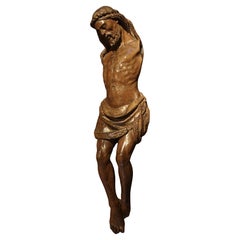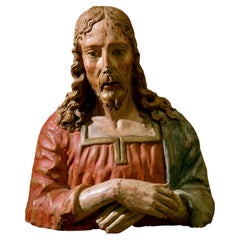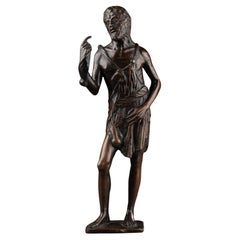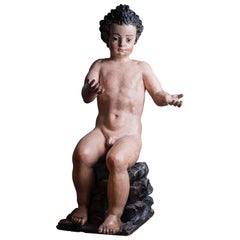Want more images or videos?
Request additional images or videos from the seller
1 of 5
The flagellation - Brabant, circa 1560
$15,413.58List Price
About the Item
- Dimensions:Height: 19.69 in (50 cm)Width: 14.97 in (38 cm)Depth: 2.76 in (7 cm)
- Style:Renaissance (Of the Period)
- Materials and Techniques:
- Place of Origin:
- Period:
- Date of Manufacture:16th century
- Condition:Repaired: the executioner at the right of the christ has been restored (visible in the pictures). Wear consistent with age and use.
- Seller Location:Bruxelles, BE
- Reference Number:1stDibs: LU6666238315552
About the Seller
5.0
Vetted Professional Seller
Every seller passes strict standards for authenticity and reliability
1stDibs seller since 2022
15 sales on 1stDibs
Authenticity Guarantee
In the unlikely event there’s an issue with an item’s authenticity, contact us within 1 year for a full refund. DetailsMoney-Back Guarantee
If your item is not as described, is damaged in transit, or does not arrive, contact us within 7 days for a full refund. Details24-Hour Cancellation
You have a 24-hour grace period in which to reconsider your purchase, with no questions asked.Vetted Professional Sellers
Our world-class sellers must adhere to strict standards for service and quality, maintaining the integrity of our listings.Price-Match Guarantee
If you find that a seller listed the same item for a lower price elsewhere, we’ll match it.Trusted Global Delivery
Our best-in-class carrier network provides specialized shipping options worldwide, including custom delivery.You May Also Like
Altarpiece Representing The Annunciation, North of Portugal, circa 1600
Located in Brussels, Brussels
Exceptional altarpiece representing the annunciation circa 1600, fruitwood
rare altarpiece from the North of Portugal, unique due to its large size representing the scene of the annunciation, where the Archangel Gabriel (represented on the bottom left), sent by god (represented on the top left) announces to Marie (bottom right) that she will give birth to Jesus.
Very good state of conservation, carved on three panels
Dimension: Height 1m51
Width 1m03
Very nice colour and exceptional dimensions
Restorations of use
We placed the altarpiece on a red velvet base and a Spanish occasional...
Category
Antique 17th Century Portuguese Renaissance Figurative Sculptures
Materials
Fruitwood
$14,811
H 59.45 in W 40.56 in D 6.3 in
Adoration of the shepherds - Large high-relief, Northern Italy Circa 1500
Located in PARIS, FR
Large high relief in carved and gilt wood, with many traces of polychromy, representing the Adoration of the Shepherds.
The evangelist Luke first mentions that the scene takes place at night. A sudden light, which frightens the shepherds, signals the arrival of an angel who announces "great joy". He gives them a sign: they will find "a newborn baby wrapped...
Category
Antique 16th Century Italian Renaissance Figurative Sculptures
Materials
Wood
$55,392
H 36.22 in W 31.89 in D 5 in
The ‘CAVALIER ARAB’, Circa 1880
By Émile Guillemin, Alfred Barye
Located in London, GB
"Cavalier Arabe”, which is a collaboration by two French sculptors Alfred Barye and Emile-Coriolan-Hippolyte Guillemin. Signed by E Guillemin and Bary f...
Category
Antique Late 19th Century French Belle Époque Figurative Sculptures
Materials
Spelter
The Coupling, Bronze, circa 1950.
Located in PARIS, FR
Large solid bronze sculpture representing a tenderly embracing couple in the process of mating.
Probably executed around 1950, this sculpture has no signature or date.
Black granite...
Category
Vintage 1950s French Mid-Century Modern Figurative Sculptures
Materials
Bronze
Spectacular Patinated Bronze SCULPTURE "The Child and the Crab" 19th Cent. VIDEO
Located in Madrid, ES
Spectacular Patinated Bronze SCULPTURE depicting "The Child and the Crab"19th century
Italy late 19th century
100 x 70cm
good conditions
Category
Antique 19th Century Italian Renaissance Figurative Sculptures
Materials
Bronze
$3,492
H 39.38 in Dm 27.56 in
Wall sculpture of the Madonna and Child, circa 1930
Located in Praha, CZ
The statue is made of plaster, shows signs of use, has chips in some places (see photo)
Original condition
Category
Vintage 1930s Czech Art Deco Figurative Sculptures
Materials
Plaster
Saint John the Baptist Sculpture, 18th Century
Located in Madrid, ES
Saint John the Baptist 18th century
Portuguese sculpture from the 18th century.
in polychrome wood.
The figure is represented standing with the lamb.
Small flaws.
Measure: ...
Category
Antique 18th Century Portuguese Renaissance Figurative Sculptures
Materials
Wood
Renaissance Style Copper Figure of a Pilgrim with a Small Dog, circa 1860
Located in San Francisco, CA
Renaissance style figure of a pilgrim with a small dog. Continental hammered, repouusse and incised copper, circa 1860.
Category
Antique Mid-19th Century Italian Renaissance Figurative Sculptures
Materials
Copper
$1,200 Sale Price
20% Off
H 8.25 in W 3.75 in D 3.75 in
Unusual Stylished Bird Sculpture in the Style of Haguenauer. Circa 1960
Located in Marcq-en-Barœul, Hauts-de-France
This stylished bird is made of nickel-plated and shell (the shell has a small repair). This is a very interesting work in the style of famous designer Franz Haguenauer, Circa 1960 (t...
Category
Vintage 1960s French Mid-Century Modern Animal Sculptures
Materials
Aluminum
$2,348
H 29.14 in W 9.85 in D 12.8 in
Saint Anthony with the Child Jesus, Wood, Mechelen School, 16th Century
Located in Madrid, ES
Saint Anthony with the Child Jesus. Wood. Mechelen School, 16th century.
Sculpture in carved wood worked, as was usual in that center, on the front because it was designed to be pla...
Category
Antique 16th Century European Renaissance Religious Items
Materials
Other
$3,492
H 11.23 in W 3.35 in D 1.38 in
More From This Seller
View AllChrist - Umbria, second half of the 15th century
Located in Bruxelles, BE
Christ
Umbria, Orvieto?
Second half of the 15th century
77 x 16.5 cm
Category
Antique 15th Century and Earlier Italian Renaissance Figurative Sculptures
Materials
Walnut
Terracotta Bust of Christ as the Redeemer, 15th Century
Located in Bruxelles, BE
A terracotta bust of Christ as The Redeemer
Tuscany or Emilia Romagna, late 15th century
Measures: 46 x 43 x 21 cm
This powerful, moving bust of...
Category
Antique 15th Century and Earlier Italian Renaissance Figurative Sculptures
Materials
Terracotta
Saint John the Baptist
- After a model by Bertoldo di Giovanni
Located in Bruxelles, BE
Saint John the Baptist
Bronze
After a model by Bertoldo di Giovanni (ca. 1440–1491)
Northern Italy, 18th century
27,5 x 8 x 5 cm
This finely cast and patinated bronze statuette ...
Category
Antique Late 18th Century Italian Renaissance Figurative Sculptures
Materials
Bronze
Cercle of Juan Martinez Montañés '1568-1649', Infant St John the Baptist
Located in Bruxelles, BE
Cercle of Juan Martinez Montañés (1568-1649)
Infant St John the Baptist
Spanish, 17th century
H 74 cm
Saint John the Baptist is here represented naked, sitting on a rock, with...
Category
Antique 17th Century Spanish Renaissance Figurative Sculptures
Materials
Wood
Followers of Jean de la Huerta, Jean de Blany ? - Saint Jerome
Located in Bruxelles, BE
Followers of Jean de la Huerta, Jean de Blany ?
Saint Jerome
Limestone
Burgundy, second half of the15th century
60,5 cm
ALR Ref : S00248050
This exquisite sculpture of Saint Jerome, carved from soft, nearly white limestone typical of eastern France, exemplifies the exceptional craftsmanship of 15th-century Burgundian art. The figure of Saint Jerome, a key figure in Christian history renowned for translating the Bible into Latin, is depicted wearing a cardinal’s hat and holding the Vulgate Bible...
Category
Antique 15th Century and Earlier French Renaissance Figurative Sculptures
Materials
Limestone
Hercules Holding a Coat of Arms, Flemish, XVII Century
Located in Bruxelles, BE
Hercules holding a coat of arms
Flemish, XVII century
White and black marble
Measures: 67 x 32 x 19 cm
Hercules is depicted naked, holding a coat of arms with the right hand an...
Category
Antique 17th Century Belgian Renaissance Figurative Sculptures
Materials
Marble, Belgian Black Marble
$13,486 Sale Price
20% Off
Recently Viewed
View AllMore Ways To Browse
Body Of Christ
16th Century Clothing
15th Century Polychrome Sculpture
18th Century Wood Cherubs
19th Century Male Nude Bronze
African Sculptures Large
Antique Bacchus
Face Mask Sculpture
Hagenauer Wood
Iron Tree Sculpture
Italian Woman Nude
Lalique Car Mascots
Life Size Female Sculpture
Little Figurine
Male Athlete
Mechanical Sculpture
Murano Glass Pear
Nude Male 19th



